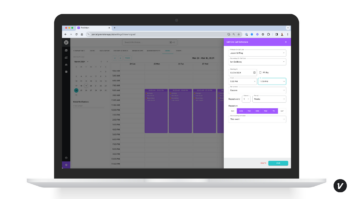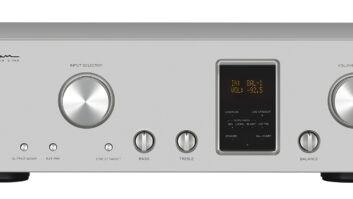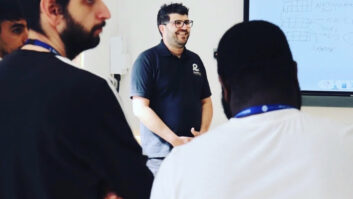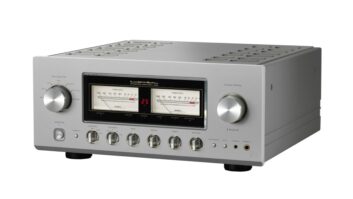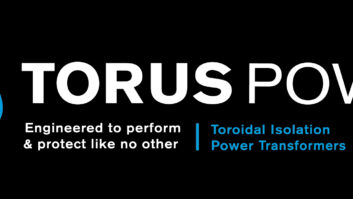It’s

that time of year again: out with the old, in with the new—perhaps more so this year, as the nation and the world watch the transition of power in Washington. With major CI channel events behind us, and the resolution of a few intense technology head to heads out of the way, this is the right time for our annual return to some of the gadgets and gizmos that drove many of us to get involved in this business in the first place.
HARNESSING BLUETOOTH’S POWER
With all the attention to the numerous applications that have appeared for Apple’s iPhone and iTouch devices, it is easy to forget that corporate “enterprise” e-mail systems still prefer the BlackBerry. With that in mind, no matter how cool you or your clients might find the “gesture” interface of the iPhone, you might have to look beyond the iPhone store for phone-based system remote applications.
Canadian firm, Unify4Life has created the $99 “AV Bridge” that takes advantage of the crisp screens and trackball-driven control on the latest Blackberry Curve, Pearl, and Bold models to control a home system. (Work is underway to add the new “Storm” model.) Communication via Bluetooth reaches a compact hub that, in turn, sends out IR commands cloned from system remotes to control up to 16 system components. With this unique product, there is no reason for you to leave Blackberry users out in the cold when it comes to system remotes—it can even control an AppleTV box.
Florida-based BlueKey Wireless also taps into phone control via Bluetooth. Its products allow Bluetooth-equipped phones to

activate relay-controlled devices, such as gate controllers along with more sophisticated products via an IR blaster module or RS-232 controlled applications. Creative programmers can greatly extend this functionality, and there is even a phone interface to deliver feedback messages.
PRESSING THE ECO BUTTON
An interesting device that came to my attention during CEDIA EXPO 2008 is the ecobutton. Reasonably priced and customizable, this is a “tschotska” that you can give to clients and prospects to show that you are tech-savvy and committed to sustainability.
The ecobutton, with one press, places your computer (PC systems only at this time) and monitor into the lowest possible power mode so that it draws a nominal amount of power that may be considerably less than the standard “sleep,” “hibernate,” or “standby” modes—in some cases as little as 1.8 watts. When you wish to return the computer to normal operational status, you simply press any key on the computer’s keyboard and you’re back in business (in most cases) without any re-boot, sign-in, or long wait time. The only hitch is that your Internet connection is suspended when the ecobutton is pressed, but traffic resumes from where the connection left off when the system is re-engaged. The ecobutton also calculates the amount of “carbon units,” as well as the actual dollar cost and electrical power saved each time the button is used to put the computer into a sleep mode. With energy cost and consumption becoming critical issues at home and in business, the reinforcement the savings display provides makes this more than just a “feel good” piece; it is a tool that makes sense.
GAMING UPDATES
During the holiday season, use the time during that “thank you” visit to your client or during that crisis service call, to make certain that the home’s video game consoles are up to date. PS3 consoles receive regular updates, some with major feature adds, and some with bug fixes. A quick check of the “System Update” tab will tell you if an update is needed. Geeky clients may do this themselves, but when the homeowner is a technophobe or if it is a vacation home, the software may need some attention.
An update is particularly

More than simple electrical or duct tape, Rescue Tape is extruded from high performance silicon, and is both self-adhering and self-fusing. relevant for Xbox 360 consoles, as the release of the “New Xbox Experience,” or “NXE” last month is a total makeover of the console’s interface. In addition to a visual refresh, many new core features have been added, not the least of which is access to movie content via Netflix. NXP also initiates a greatly improved social networking experience with customizable, animated Avatars and the Xbox LIVE Primetime channel that facilitates multiplayer live “game shows” and more entertainment options and channels for downloadable content.
When it comes to Sony’s PSP hand-held device, you should also query your clients about version numbers, as even the latest slimline versions of the PSP may need an update to the 5.0 or higher software. The older the SW version, the smaller the chance that the PSP includes 5.0 features, such as direct links to the PlayStation store, a full-size on-screen virtual

Designed primarily for image intake from HD and analog sources, the Intensity and Intensity Pro cards from Blackmagic Design, work with Windows and Mac OS X-based computers and are unique in that their input can also be from HDMI sources up to full 1920 x 1080 resolution. keyboard, and previous feature adds such as Internet radio and Skype functionality. As with the PS3 software, you can save time by downloading the files to a Memory Stick (for PSP) or USB drive (for PS3) before you leave the shop. That will have your techs ready to load it in without waiting for a download.
You might also want to ask clients if any of their new games and accessories require installation or configuration from your team. For Wii, this might include the “Wii Speak” microphone that is part of the new “Animal Crossing: City Folk” game. For those who struggled to add the Wii Bar in home theaters where there is a drop screen, placement of the Wii Speak microphone might pose a similar issue that you need to address.
If the client turns the table and asks what part of the games installation you can easily improve, one suggestion for PS3 homes might be the wireless keypad that will be available for under $50 this month. Where someone uses the PS3’s browser or prefers games or activities where there is text messaging, this compact keyboard is designed to fit precisely atop the standard SIXAXIS or DUALSHOCK3 wireless controllers and does away with the need to use the onscreen text entry function. Also requiring configuration for clients who are truly technology averse, is the Bluetooth headset that accompanies the new PS3 “Socom: Confrontation” game.
SILICON TO THE RESCUE
Who can ignore a product named “Rescue Tape?” More

Wing Dings fit over the F-Connectors used with RG-59 and RG-6 coax cable, and include a grommet that fits over the chassis port/female connection. The beauty of this is that you put them on without having to take the connector off. than simple electrical or duct tape, it is extruded from high performance silicon, is both self-adhering and self-fusing, and with a low “cold brittle point,” provides a wide operating range. You can wrap a few winds of Rescue Tape around more or less anything, providing you with a tight, air- and waterproof seal that will also serve as an insulator up to 8,000 volts. The permanent seal will resist oil, salt water, and UV, and work in temperatures up to 500 degrees. This product works so well that once you use it to secure or bind something, you will have a tough time taking it off. Available in a variety of colors and widths, if you need to protect an outdoor connection or joint, separate conductors or bundle cables together, you may find that the name of this stuff should be changed from “Rescue Tape” to “Miracle Tape.”
LORD OF THE RINGS
Another “good things come in small packages” item is “Wing Ding” Torque Wrenches and Coding Rings from CablePrep, a company that specializes in tools and products for the CATV industry. Wing Dings fit over the F-Connectors used with RG-59 and RG-6 coax cable, and include a grommet that fits over the chassis port/female connection. The beauty of this is that you put them on without having to take the connector off.
The ridges on the larger ring are used for leverage to hand-tighten the connector, ensuring that the connection is tight enough to prevent signal loss without damage to the connector itself. The ridges also make it easy to grasp the connector and tighten it when you are reaching behind a product or inside a cabinet.
To make it even better, both the grommet rings and the Torque Wrenches are color coded so that when there are multiple RF connections you can easily see which lead goes to which port. Inexpensive and simple, they are time savers that make your installations easier and more reliable.
WORKING BLACK MAGIC
Designed primarily for image intake from HD and analog sources, the Intensity and Intensity Pro cards from Blackmagic Design, work with Windows and Mac OS X-based computers and are unique in that their input can also be from HDMI sources up to full 1920 x 1080 resolution. This is a benefit for ingesting content for digital editing, but it also makes it possible to take in HD content (provided that it is not copy protected) from AVRs and other source devices so that you can screen capture GUI and

Atlona’s new HDPiX is a plug-andplay USB-to-HDMI adapter that allows the addition of an HDMI output to virtually any PC or Mac. OSD messages from products. This, in turn, allows you to use the GUI screens for custom manuals for your clients or for internal staff training presentations. The alternative isn’t pretty, as standard capture devices are either Firewire, which doesn’t help with most audio/video components, or analog composite or S-video, which limits you to low-resolution images that might not show the products you have sold and are about to install to their full potential.
USB TO HDMI
Atlona Technologies has solved the opposite HDMI problem that Blackmagic Design addresses. The company’s new HDPiX is a plug-and-play USB-to- HDMI adapter that allows the addition of an HDMI output to virtually any PC or Mac, be it a desktop, laptop or HTPC. Resolutions up to 720p (1600 x 1200) are supported to a 12-bit color depth and you can even add audio to the HDMI feed via a 3.5mm stereo mini-jack.
If you are wondering what an application for this could be, think beyond the need to add a PC to a home entertainment system. When a relative of ours was confined to bed for two weeks following back surgery, there was a problem in connecting his computer for Web surfing and online banking to an LCD display in the bedroom that had no VGA input. We did it the hard way, taking the computer apart and installing a new video card with a DVI output that was then converted to HDMI with an adapter cable. Glad to do it, but a pain in the neck. With the HDPix it would have taken a few minutes, rather than over an hour of installation and configuration. Your ability to handle the occasional off the regular path job site problem such as this with a low-cost, easy-to-use product shows your clients that you have true knowledge of your craft.
NOTING YOUR LOCATION
Another product seemingly unrelated to what we do is Trips & Pics from GPS supplier Pharos. The obvious part of this product is the standard GPS receiver, which

Trips & Pics from Pharos is a GPS product that lets you precisely record the position of outdoor locations on a job site. stores positioning readings for up to 24 hours on a single charge and stores up to 45 days of data or 13,000 records. However, with the software that comes with the product and a USB dongle that lets you transfer data from the GPS device to your computer, the value of the product begins to show through.
When you use the GPS module in proximity to your digital camera, and provided that the time clock in the camera is calibrated (the software lets you do that, too), when you download the GPS data and the image files into a computer, the software matches the two files up and synchronizes them. That lets you precisely record the position of outdoor locations on a job site, whether it is the pool house, the front gate, or different spots on a building’s roof.
That, however, is only the start of the fun. With the image and GPS data aligned the software will not only let you create position-accurate captions, you can link to Google Earth, Virtual Earth, and Microsoft Streets & Trips to create a map-based presentation that shows where the photo was taken in relation to other buildings or physical landmarks. That is a great way to not only document building, antenna and property features for job planning, it also makes for unique outstanding bid package presentation—a great double-play with Trips & Pics, something that could not only help you land the job, but also a tool that helps you to document it for more efficient work flow.
Michael Heiss ([email protected]) is a technology guru for the AV industry, based in Los Angeles, California.
